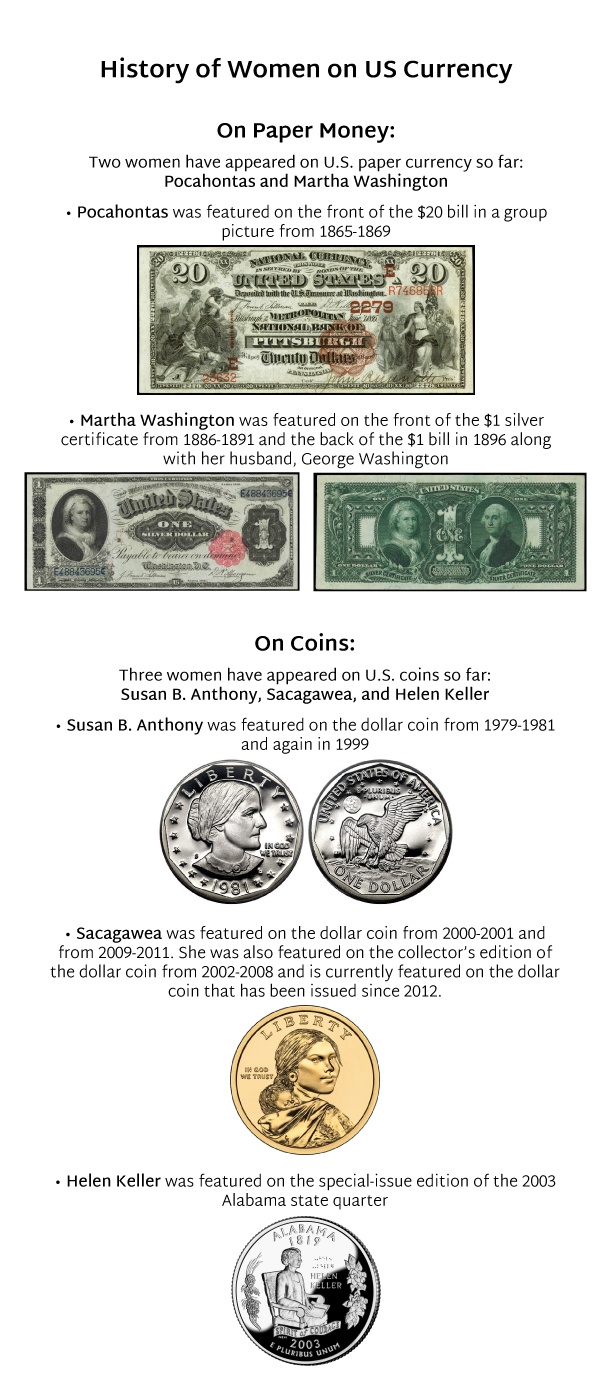
Harriet Tubman on the $20 Bill & the Redesigns of the $5 Bill and $10 Bill
On April 20, Jacob J. Lew, the Secretary of the Treasury, announced that a redesign of the $20 bill will feature abolitionist Harriet Tubman on the front of the bill, moving Andrew Jackson to the back of the bill. In addition, the $5 bill and the $10 bill will be redesigned. The back of the new $5 bill will feature Martin Luther King Jr., Eleanor Roosevelt, and opera singer Marian Anderson. The back of the new $ 10 bill will feature the Women’s Suffrage Parade of 1913 and five women suffrage movement leaders.
Harriet Tubman will be the first African-American ever to be placed on US currency and the first woman to be placed on US paper currency in more than a century.
The new design of the $10 bill is set to be released first, in 2020, coinciding with the 100th anniversary of the passage of the 19th Amendment, which gave women the right to vote. The new design of the $5 bill and the $20 will be released afterwards.
Why are the $5, $10, and $20 bills going to be redesigned?
About 10 months ago, in June 2015, Lew addressed the gender representation imbalance of US paper currency by announcing that the Treasury will be putting a woman on the front of the $10 bill when it is redesigned. He did not announce which historical American woman would be chosen – he would choose after getting input from the public as to which woman should go on the front of the bill.
Although the $10 bill, as well as the $5 bill and the $20 bill, was already due for a redesign when Lew made his announcement, the call for redesign was prompted in 2015 in part by a girl in third grade, who wrote a letter to Obama to ask why there aren’t any women on US bills, and an online group known as “Women on 20s”, who sent the results of a poll of 600,000 people who determined that Harriet Tubman should be placed on a bill.

Even though the announcement in 2015 did not explicitly say who would be on the new design of the $10 bill, the idea of removing Alexander Hamilton from the front of the $10 bill caused controversy.
Gender diversity advocates vs. Alexander Hamilton fans controversy
A few months prior to Lew making his 2015 announcement, “Hamilton” debuted off-Broadway. “Hamilton” is a musical about the life and death of Alexander Hamilton, the first Secretary of the Treasury, who is credited with the creation of the US financial system. It quickly became such a hit musical that it was moved to Broadway just six months later.
The popularity of the musical caused a reciprocal resurgence on popularity of Alexander Hamilton, the person. And thus, at the intersection of the rise of Alexander Hamilton’s popularity and announcement that Alexander Hamilton would be removed from the face of the $10 bill, controversy erupted.
The placement of Hamilton isn’t unwarranted - Hamilton, after all, is considered the architect of the successful debt repayment structure for the debt America incurred during the Revolutionary War. Hamilton’s financial prowess still remains unparalleled to this day; Ben Bernake, former Chairman of the Federal Reserve, considers Hamilton to be “the best and most foresighted economic policy maker in U.S. history”.
The removal of Alexander Hamilton from the front of the $10 bill and subsequent replacement with a woman figure was met with acceptance and support by various women and gender diversity groups, which only furthered the controversy.
Although Lew didn’t publicly hint that Alexander Hamilton would remain on the face of the $10 bill until earlier this year, he had decided to keep Hamilton as far back as July 2015. Lew’s first public mention that Hamilton would remain on the front of the $10 bill occurred on March 30 in an interview, when he suggested that a woman wouldn’t be on the front of the $10 bill and that Hamilton would be remaining right where he was.
On April 20, Lew announced his compromise:
- Hamilton will remain on the face of the $10 bill, but the back of the $10 bill will depict Women’s Suffrage Parade of 1913 and five pivotal women’s suffrage movement leaders: Susan B. Anthony, Alice Paul, Sojourner Truth, Elizabeth Cady Stanton, and Lucretia Mott
- Harriet Tubman will replace Andrew Jackson as the figure on the front of the $20 bill, and Jackson will be placed on the back of the bill along with the current image on the back of the $20 bill, the White House
How the new designs were determined
To Lew, the redesign of US paper currency was the “chance to open the aperture to reflect more of America’s history”. After careful consideration, with help from the public’s input, Lew decided that Harriet Tubman best represented the essence of America’s history; Harriet Tubman is undeniably most well-known for her unwavering leadership and dedication to helping others.
Harriet Tubman grew up as a slave on a Maryland plantation and managed to escape when she was in her late 20s. After escaping, she risked her freedom to make many trips back to the South to lead hundreds of slaves to freedom in the North and Canada. During the Civil War, Tubman worked as a spy for the North. After the war, Tubman was an active participant in the burgeoning women’s suffrage movement.
Of Tubman, Lew said:
“It’s the essential story of American democracy about how one person who grew up in slavery, never had the benefit of learning how to read or write, could change the course of history . . . the pattern became clear that Harriet Tubman struck a chord with people in all parts of the country, of all ages”
Although he initially publicized that a woman would be appearing on the front of the $10 bill, Lew later reasoned that a woman figure should be placed on a “bigger” bill, saying that he “had a kind of ‘aha’ moment where [he] said we’re thinking too small”.
At that point, the choice became clear: remove Andrew Jackson from the front of the $20 bill and replace him with a woman.
There were two main points that supported the replacement of Andrew Jackson as the face of the $20 bill:
- The $20 bill is arguably a much more popular and widely circulated than the $10 bill
- Andrew Jackson has not experienced the revival in popularity that Hamilton has, but more importantly, he had quite the controversial life:
- he was a slave owner
- he played a major role in forcing Native Americans from their homelands
- he opposed not only the national banking system, but also, paper currency
In addition to the addition and rearrangement of the figures appearing on the $5 bill, $10 bill, and $20 bill, Lew said that the redesigns will “bring to life” the national monuments that are featured on the bills.
Although the planned redesign was announced just a couple of days ago, the new design of the $10 bill will not debut until 2020 - the 100 year anniversary of the passage of the 19th Amendment which gave women the right to vote. The new designs of the $5 bill and $20 bill will be debuted after the $10 bill. The $10 bill is said to be the first to be released due to security concerns. The redesigned bills won’t enter circulation until later in the decade, but before 2030, at a date that will be determined in the future by the Federal Reserve.
It should be noted that the 2020 release of the $10 bill should be considered tentative until announced otherwise, as there have been doubts already as to whether or not the design can be completed in time.
Why will it take so long to design and release new bill designs?
The process of redesigning currency is quite time-consuming due to the exact and refined nature of US currency production.
In 1982, the Advanced Counterfeit Deterrence (ACD) Steering Committee was established at the Department of the Treasury. The purpose of the ACD was to:
- monitor counterfeiting activity and make recommendations to the Secretary of the Treasury on how to handle counterfeiting activity
- determine which existing and/or emerging technology to incorporate as security features into currency to deter counterfeiting
Simultaneous to the ACD determining which security features to use, artists work to create the overall look, layout, and artistic details of the new currency, balancing design with reproducibility so that the designs will be able to be reproduced using currency manufacturing machines. Cutting-edge digital technologies as well as classic design tools, such as the pen and pencil, are used to develop new currency designs.
Once security features have been determined, the artists and designers incorporate them into their design of the new currency, much in the manner of piecing together a puzzle.
The goal of the redesign is to seamlessly incorporate the selected security features into design elements in order to maintain the look and feel of currency that captures America’s unique culture and history as well as the strength of the American economy.
The entire process of redesigning currency will likely need dozens of drafts and rounds of testing over the course of several years because the final design is ready to be approved by the Secretary of the Treasury. Once it has been approved, the final designs need to be manufactured and released into circulation.
A List of the Changes to the $5, $10, and $20 Bills
The following is a graphic detailing the proposed changes to the $5, $10, and $20 bills.






.png)
